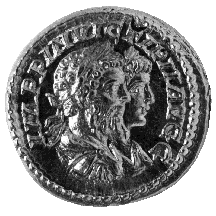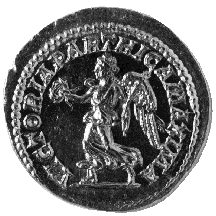



(111) Septimius Severus and Antoninus ("Caracalla")
- AV aureus, A.D. 204, 7.14 g. (inv. 91.199).
Obverse: Jugate busts of Septimius Severus and Antoninus r., both laureate,
draped, and cuirassed; IMPP (IMPERATORES abbreviated) INVICTI PII AVGG (AVGVSTI
abbreviated): invincible imperators, pious Augusti.
Reverse: Victoria advancing l., with wreath in r. and palm in l.; VICTORIA
PARTHICA MAXIMA: Greatest Parthian victory.
Provenance: Ex Ryan collection; Patrick Doheny collection; Sotheby's, 1979.
Bibliography: H. Mattingly and E.A. Sydenham, The Roman Imperial Coinage
IV.1: Pertinax to Geta (London 1936) 311; P.V. Hill, The Coinage
of Septimius Severus and his Family of the Mint of Rome AD 193-217 (London
1964) 30.
In the period of the civil wars following the murder of Pertinax, Septimius
Severus had to contend with several rivals for the throne. One was Pescennius
Niger, who had been proclaimed emperor by his troops in Syria. Once he had
dealt with Niger, Severus moved against his allies in the region, including
one of the empire's oldest and most intractable enemies, the Parthians.
In this campaign Severus defeated them and annexed Mesopotamia. When the
Parthians attempted to recover it in A.D. 197, Severus marched deep into
their territory and in A.D. 198 captured the Parthian capital, Ctesiphon.
For this victory Severus was awarded the title Parthicus maximus,
greatest conqueror of the Parthians, and the victory was celebrated for
some years after the actual event. The reverse of this coin hails the victory
and appropriately depicts Victoria, the personification of victory, with
her usual attributes, the wreath and palm.
The jugate busts of Severus and Antoninus (Caracalla) are indicative of
their joint rule. This coin is unusual in its omission of their names from
the obverse legend.
R.E.B.



All contents copyright (c) 1996.
Lawrence University
All rights reserved.